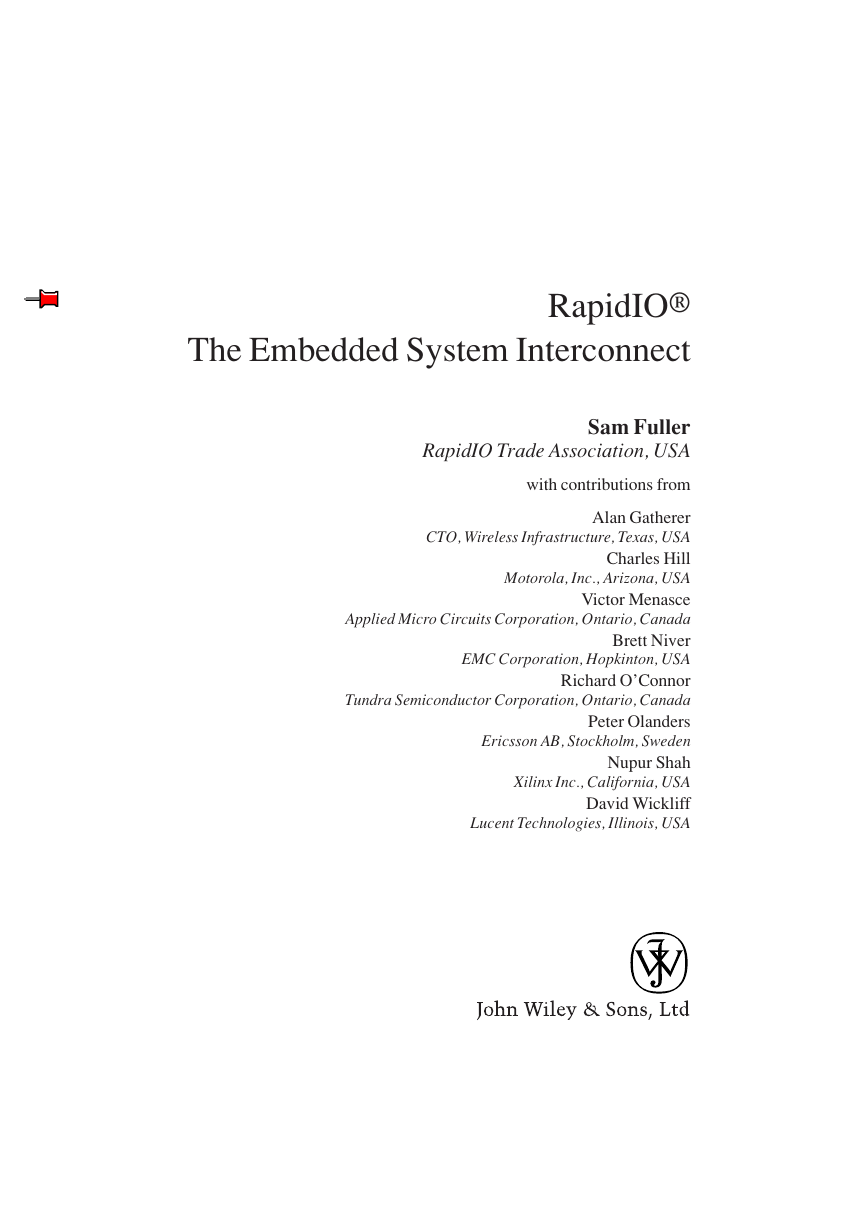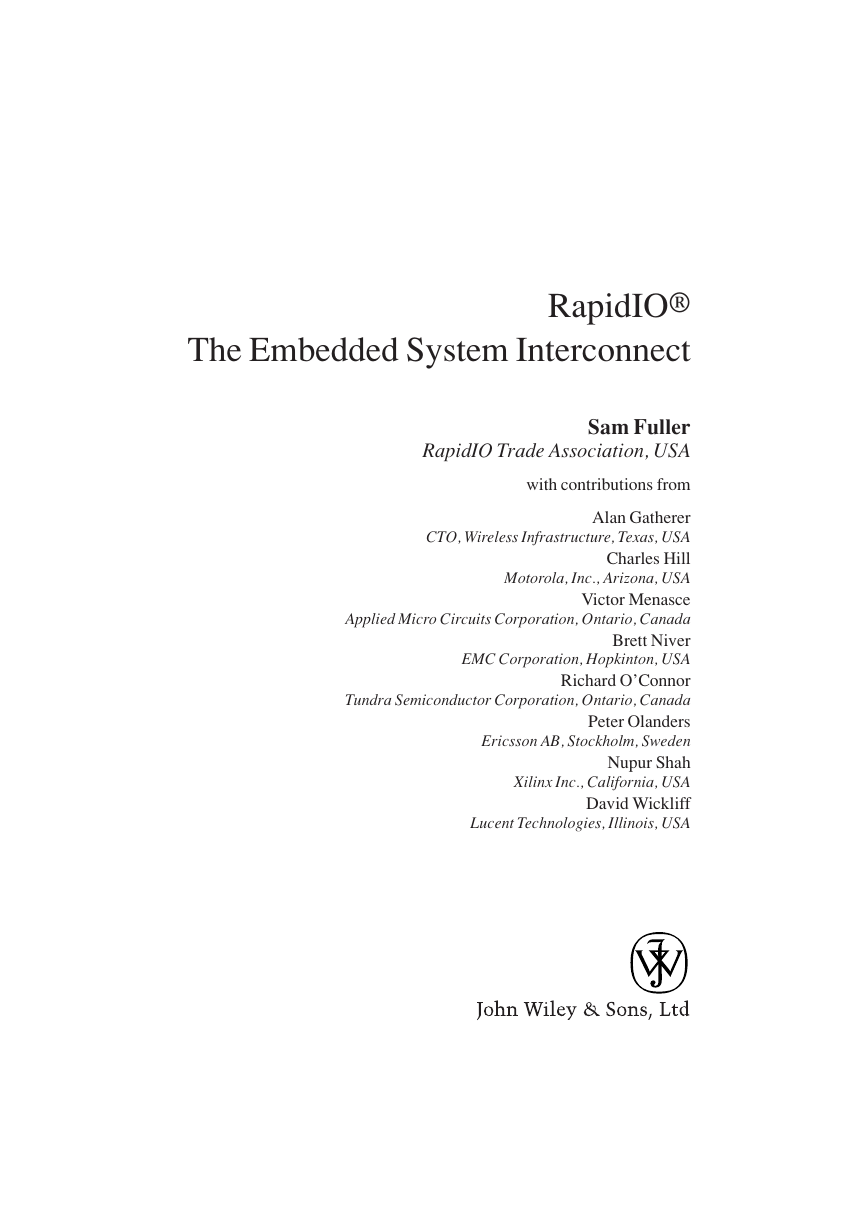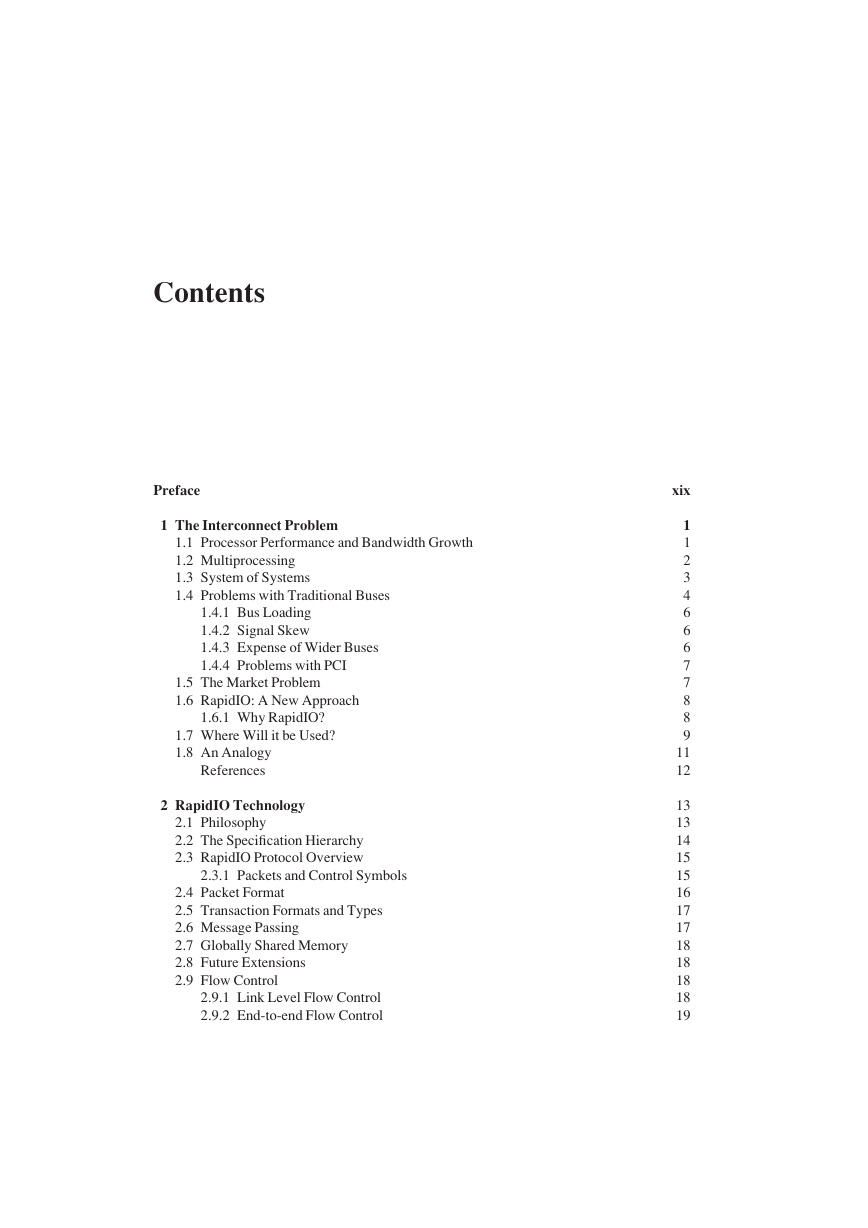RapidIO® The Embedded System Interconnect
Contents
Preface
1 The Interconnect Problem
1.1 Processor Performance and Bandwidth Growth
1.2 Multiprocessing
1.3 System of Systems
1.4 Problems with Traditional Buses
1.4.1 Bus Loading
1.4.2 Signal Skew
1.4.3 Expense of Wider Buses
1.4.4 Problems with PCI
1.5 The Market Problem
1.6 RapidIO: A New Approach
1.6.1 Why RapidIO?
1.7 Where Will it be Used?
1.8 An Analogy
References
2 RapidIO Technology
2.1 Philosophy
2.2 The Specification Hierarchy
2.3 RapidIO Protocol Overview
2.3.1 Packets and Control Symbols
2.4 Packet Format
2.5 Transaction Formats and Types
2.6 Message Passing
2.7 Globally Shared Memory
2.8 Future Extensions
2.9 Flow Control
2.9.1 Link Level Flow Control
2.9.2 End-to-end Flow Control
2.10 The Parallel Physical Layer
2.10.1 Parallel Electrical Interface
2.11 The Serial Physical Layer
2.11.1 PCS and PMA Layers
2.11.2 Electrical Interface
2.12 Link Protocol
2.13 Maintenance and Error Management
2.13.1 Maintenance
2.13.2 System Discovery
2.13.3 Error Coverage
2.13.4 Error Recovery
2.14 Performance
2.14.1 Packet Structures
2.14.2 Source Routing and Concurrency
2.14.3 Packet Overhead
2.15 Operation Latency
References
3 Devices, Switches, Transactions and Operations
3.1 Processing Element Models
3.1.1 Integrated Processor-memory Processing Element Model
3.1.2 Memory-only Processing Element Model
3.2 I/O Processing Element
3.3 Switch Processing Element
3.4 Operations and Transactions
3.4.1 Operation Ordering
3.4.2 Transaction Delivery
3.4.3 Ordered Delivery System Issues
3.4.4 Deadlock Considerations
4 I/O Logical Operations
4.1 Introduction
4.2 Request Class Transactions
4.2.1 Field Definitions for Request Class Transactions
4.3 Response Class Transactions
4.3.1 Field Definitions for Response Packet Formats
4.4 A Sample Read Operation
4.5 Write Operations
4.6 Streaming Writes
4.7 Atomic Operations
4.8 Maintenance Operations
4.9 Data Alignment
5 Messaging Operations
5.1 Introduction
5.2 Message Transactions
5.2.1 Type 10 Packet Format (Doorbell Class)
5.2.2 Type 11 Packet Format (Message Class)
5.2.3 Response Transactions
5.3 Mailbox Structures
5.3.1 A Simple Inbox
5.3.2 An Extended Inbox
5.3.3 Receiving Messages
5.4 Outbound Mailbox Structures
5.4.1 A Simple Outbox
5.4.2 An Extended Outbox
5.4.3 Transmitting Messages
6 System Level Addressing in RapidIO Systems
6.1 System Topology
6.2 Switch-based Systems
6.3 System Packet Routing
6.4 Field Alignment and Definition
6.5 Routing Maintenance Packets
7 The Serial Physical Layer
7.1 Packets
7.1.1 Packet Format
7.1.2 Packet Protection
7.1.2.1 Packet CRC Operation
7.1.2.2 16-Bit Packet CRC Code
7.2 Control Symbols
7.2.1 Stype0 Control Symbol Definitions
7.2.1.1 Packet-accepted Control Symbol
7.2.1.2 Packet-retry Control Symbol
7.2.1.3 Packet-not-accepted Control Symbol
7.2.1.4 Status Control Symbol
7.2.1.5 Link-response Control Symbol
7.2.2 Stype1 Control Symbol Definitions
7.2.2.1 Start-of-packet Control Symbol
7.2.2.2 Stomp Control Symbol
7.2.2.3 End-of-packet Control Symbol
7.2.2.4 Restart-from-retry Control Symbol
7.2.2.5 Link-request Control Symbol
7.2.2.6 Multicast-event Control Symbol
7.2.3 Control Symbol Protection
7.2.3.1 CRC-5 Code
7.3 PCS and PMA Layers
7.3.1 PCS Layer Functions
7.3.2 PMA Layer Functions
7.3.3 Definitions
7.3.4 The 8B/10B Transmission Code
7.3.5 Character and Code Group Notation
7.3.6 Running Disparity
7.3.6.1 Running Disparity Rules
7.3.7 8B/10B Encoding
7.3.8 Transmission Order
7.3.9 8B/10B Decoding
7.3.10 Special Code Groups and Characters
7.3.10.1 Packet Delimiter Control Symbol (/PD/)
7.3.10.2 Start of Control Symbol (/SC/)
7.3.10.3 Idle (/I/ )
7.3.10.4 Sync (/K/)
7.3.10.5 Skip (/R/)
7.3.10.6 Align (/A/)
7.4 Using the Serial Physical Layer
7.4.1 Port Initialization Process
7.4.2 Packet Exchange Protocol
7.4.2.1 Control Symbols
7.4.2.2 Packets
7.4.3 Idle Sequence
7.4.4 Data Flow Across a 1x Serial RapidIO Link
7.4.5 Data Flow Across a 4x Serial RapidIO Link
7.4.6 Flow Control
7.4.6.1 Receiver-controlled Flow Control
7.4.6.2 Transmitter-controlled Flow Control
7.4.6.3 Input Retry-stopped Recovery Process
7.4.6.4 Output Retry-stopped Recovery Process
7.4.7 Link Maintenance Protocol
7.4.8 Canceling Packets
7.5 Transaction and Packet Delivery Ordering Rules
7.5.1 Deadlock Avoidance
7.6 Error Detection and Recovery
7.6.1 Lost Packet Detection
7.6.2 Link Behavior Under Error
7.6.3 Effect of Single-bit Code Group Errors
7.6.4 Recoverable Errors
7.6.4.1 Input Error-stopped Recovery Process
7.6.4.2 Output Error-stopped Recovery Process
7.6.4.3 Idle Sequence Errors
7.6.4.4 Control Symbol Errors
7.6.4.5 Reserved stype and cmd Field Encodings
7.6.4.6 Link Protocol Violations
7.6.4.7 Corrupted Control Symbols
7.6.4.8 Packet Errors
7.6.4.9 Link Time-out
7.7 Retimers and Repeaters
7.8 The Electrical Interface
8 Parallel Physical Layer Protocol
8.1 Packet Formats
8.2 Control Symbol Formats
8.2.1 Acknowledgment Control Symbol Formats
8.2.1.1 Packet-accepted Control Symbol
8.2.1.2 Packet-retry Control Symbol
8.2.1.3 Packet-not-accepted Control Symbol
8.2.2 Packet Control Symbols
8.2.3 Link Maintenance Control Symbol Formats
8.2.3.1 Link Request Control Symbol
8.2.3.2 Link Response Control Symbol
8.3 Control Symbol Transmission Alignment
8.4 Packet Start and Control Symbol Delineation
8.5 Packet Exchange Protocol
8.5.1 Packet and Control Alignment
8.5.2 Acknowledge Identification
8.6 Field Placement and Definition
8.6.1 Flow Control Fields Format
8.6.2 Packet Priority and Transaction Request Flows
8.6.3 Transaction and Packet Delivery
8.6.4 Control Symbol Protection
8.6.5 Packet Protection
8.6.6 Transactional Boundaries
8.7 Link Maintenance Protocol
8.7.1 Command Descriptions
8.7.1.1 Reset and Safety Lockouts
8.7.1.2 Input-status
8.7.1.3 Send-training
8.7.2 Status Descriptions
8.8 Packet Termination
8.9 Packet Pacing
8.10 Embedded Control Symbols
8.11 Packet Alignment
8.12 System Maintenance
8.12.1 Port Initialization
8.12.1.1 Port Width Mode Selection
8.12.1.2 Ports Not Requiring Port Initialization
8.12.1.3 Ports Requiring Port Initialization
8.12.1.4 Port Initialization Process
8.12.2 Link Initialization
8.12.3 Training
8.12.3.1 Training Pattern
8.12.3.2 Training Pattern Transmission
8.12.3.3 Maintenance Training
8.12.3.4 Unexpected Training Pattern Reception
8.13 System Clocking Considerations
8.13.1 Example Clock Distribution
8.13.2 Elasticity Mechanism
8.14 Board Routing Guidelines
8.14.1 Impedance
8.14.2 Skew
8.14.3 PCB Stackup
8.14.4 Termination
8.14.5 Additional Considerations
8.14.5.1 Single Board Environments
8.14.5.2 Single Connector Environments
8.14.5.3 Backplane Environments
9 Interoperating with PCI Technologies
9.1 Address Map Considerations
9.2 Transaction Flow
9.2.1 PCI 2.2 to RapidIO Transaction Flow
9.2.1.1 Posted PCI to RapidIO Transaction
9.2.1.2 Non-posted PCI to RapidIO Transaction
9.2.1.3 RapidIO to PCI Transaction
9.3 PCI-X to RapidIO Transaction Flow
9.4 RapidIO to PCI Transaction Mapping
9.5 Operation Ordering and Transaction Delivery
9.5.1 Operation Ordering
9.5.2 Transaction Delivery Ordering
9.5.3 PCI-X Relaxed Ordering Considerations
9.6 Interactions with Globally Shared Memory
9.7 Byte Lane and Byte Enable Usage
9.8 Error Management
10 RapidIO Bringup and Initialization Programming
10.1 Overview of the System Bringup Process
10.1.1 Boot Requirements
10.1.2 Enumeration
10.1.3 Address Space Mapping
10.2 System Application Programming Interfaces
10.2.1 Basic Hardware Abstraction Layer (HAL) Functions
10.2.2 RapidIO Bringup HAL Functions
10.2.3 Routing-table Manipulation HAL Functions
10.2.4 Device Access Routine (DAR) Functions
10.3 System Bringup Example
11 Advanced Features
11.1 System-level Flow Control
11.1.1 Interconnect Fabric Congestion Example
11.1.2 System-level Flow Control Operations
11.1.3 End Point Flow Control Rules
11.1.4 Switch Flow Control Rules
11.2 Error Management Extensions
11.2.1 Hot-insertion/extraction
11.2.2 The Port-write Transaction
11.2.3 Persistence of Error Management Registers
11.2.4 Error Management Extensions
11.3 Memory Coherency Support
11.3.1 Features of the Globally Shared Memory (GSM) Specification
11.4 Multicasting Transactions in RapidIO
11.4.1 RapidIO Multicast Support
11.4.2 Multicast Ordering Requirements
11.4.3 Multicast Programming Model
11.4.4 Other Multicast Characteristics
11.5 Multicasting Symbols
11.5.1 Example of Use of Multicast-event Control Symbol
12 Data Streaming Logical Layer
12.1 Introduction
12.2 Type 9 Packet Format (Data Streaming Class)
12.3 Virtual Streams
12.3.1 Class of Service, Virtual Queues
12.3.2 RapidIO Flows
12.3.3 Segmentation and Reassembly
12.3.4 Segmentation Contexts
12.3.5 Reassembly
12.4 Configuring Data Streaming Systems
12.5 Advanced Traffic Management
12.6 Using Data Streaming
12.6.1 CSIX to RapidIO Data Streaming Interface
12.6.1.1 Introduction to CSIX Packet Formats
12.6.1.2 Adapting CSIX to RapidIO Data Streaming Format
12.6.1.3 Flow Control
12.6.2 Ethernet and IP Applications
12.6.3 Ethernet Switching
12.6.4 IP Switching
12.6.5 TCP Offload
12.6.6 RapidIO to ATM
Reference
13 Applications of the RapidIO Interconnect Technology
13.1 RapidIO in Storage Systems
13.1.1 Features of Storage
13.1.2 Capacity
13.1.3 Availability
13.1.4 Density
13.1.5 Manageability
13.1.6 Storage System Applications of RapidIO
13.1.6.1 Storage Requirements
13.1.7 Conclusion
13.2 RapidIO in Cellular Wireless Infrastructure
13.2.1 Introduction to Wireless Infrastructure
13.2.2 Mobile Switching Center/GPRS Support Node
13.2.3 Core Network Interface
13.2.4 Transcoding and Transrating
13.2.5 Radio Network Control
13.2.6 Basestation
13.2.7 RapidIO For Wireless Infrastructure
13.2.7.1 Simplification with RapidIO
13.2.7.2 Architectural Possibilities with RapidIO
13.2.8 Conclusions
13.3 Fault-tolerant Systems and RapidIO
13.3.1 Key Elements of Fault Tolerance
13.3.1.1 No Single Point of Failure
13.3.1.2 No Single Point of Repair
13.3.1.3 Fault Recovery Support
13.3.1.4 100% Fault Detection
13.3.1.5 100% Fault Isolation
13.3.1.6 Fault Containment
13.3.2 Live Lock and Head of Queue Blocking
13.3.3 A System Example
13.3.4 Summary
References
14 Developing RapidIO Hardware
14.1Introduction
14.1.1 Implementation Performance–Cost Analysis
14.1.2 Logical Layer Transaction Considerations
14.1.3 RapidIO Transport Layer Considerations
14.1.4 RapidIO Physical Layer Considerations
14.1.5 Protocol Bridging Considerations
14.1.6 Transaction Buffering Considerations
14.1.7 Clocking Considerations
14.1.8 Packet Data Alignment Considerations
14.1.9 Data Recovery Considerations
14.2 Implementing a RapidIO End Point
14.2.1 End Point Overview
14.2.2 Implementing RapidIO in an End Point
14.2.3 Transaction Routing: Terminating End Point
14.2.4 Implementing Logical and Transport Layer Functions
14.2.5 Implementing Serial Physical Layer Functions
14.2.6 Implementing Parallel Physical Layer Functions
14.2.7 Outbound Transaction Flow
14.2.8 Sample Outbound Module
14.2.8.1 Re-transmit Queue
14.2.8.2 Packet Generator
14.2.8.3 Control Symbol Generator
14.2.8.4 Logical Outbound Module
14.2.9 Inbound Transaction Flow
14.2.10 Sample Inbound Module
14.2.10.1 Destination IDs
14.2.10.2 End Point Inbound Module
14.2.10.3 Transport Layer
14.2.10.4 Inbound Buffers
14.2.10.5 Response, Port-write Out and Debug Packet Assembler
14.2.10.6 Elastic Rx/Tx FIFO and Lane Alignment
14.2.11 Acknowledgment Symbol History Queue
14.3 Supporting Functions
14.3.1 RapidIO Controller Configuration
14.3.2 Link Training
14.3.3 Device Maintenance
14.3.4 Performance Monitoring
14.3.4.1 Traffic Efficiency
14.3.4.2 Bit Error Rate
14.3.4.3 Throughput
14.3.4.4 Bottleneck Detection
14.3.4.5 Congestion Detection
14.3.5 Error Handling
14.3.5.1 Recoverable Errors
14.3.5.2 Inbound and Outbound Packet Errors
14.3.5.3 Control Symbol Errors
14.3.5.4 Non-recoverable Errors
14.3.5.5 Outbound Port-write
14.3.5.6 Inbound Port-write
14.3.6 Interrupts
14.3.6.1 Sample Controller Interrupts
14.3.6.2 Switching Fabric Interrupts
14.3.6.3 Terminating End Point
14.3.6.4 Bridging Device Interrupts
14.3.6.5 Mapping to Interrupt Output Pins
14.3.7 Reset
14.3.8 Clocking
14.3.8.1 Parallel Switch Clocking
14.3.8.2 End Point Clocking
14.3.8.3 RapidIO Interface PLL Configuration
14.3.8.4 Sample PLL Bypass
14.3.8.5 Serial Switch Clocking
14.4 Implementing a RapidIO Switch
14.4.1 Switch Features
14.4.2 Switch Performance and Cost Implications
14.4.3 Implementing RapidIO in a Switch
14.4.3.1 Inbound and Outbound Modules
14.4.3.2 Sample Inbound Module
14.4.3.3 Destination IDs
14.4.3.4 Switch Packet Priority
14.4.4 Port Mirroring Capability
14.4.5 Sample Outbound Module
14.4.6 Internal Switching Fabric
14.4.7 Packet Routing: Routing Tables
14.5 Summary
15 Implementation Benefits of the RapidIO Interconnect Technology in FPGAs
15.1 Building the Ecosystem
15.2 Advances in FPGA Technology
15.2.1 I/O Connectivity Options
15.2.2 Rich Logic Fabrics
15.2.3 The IP Portfolio
15.3 Multiprotocol Support for the Embedded Environment
15.4 Simple Handshake
15.5 Low Buffering Overhead
15.6 Efficient Error Coverage
15.7 Conclusion
16 Application of RapidIO to Mechanical Environments
16.1 Helpful Features for Mechanical Environments
16.2 Channel Characteristics
16.3 Industry Standard Mechanical Platforms Supporting RapidIO
16.3.1 RapidIO Hardware Interoperability Platform (HIP)
16.3.2 CompactPCI Serial RapidIO (PICMG 2.18)
16.3.3 AdvancedTCA Serial RapidIO (PICMG 3.5)
16.3.4 Switched Mezzanine Card XMC (VITA 42)
16.3.5 Advanced Mezzanine Card Serial RapidIO (PICMG AMC)
16.3.6 VME Switched Serial VXS for RapidIO (VITA 41.2)
16.3.7 Advanced Module Format (VITA 46)
16.4 Summary
Appendix A RapidIO Logical and Transport Layer Registers
A.1 Reserved Register and Bit Behavior
A.2 Capability Registers (CARs)
A.2.1 Device Identity CAR (Offset 0x0 Word 0)
A.2.2 Device Information CAR (Offset 0x0 Word 1)
A.2.3 Assembly Identity CAR (Offset 0x8 Word 0)
A.2.4 Assembly Information CAR (Offset 0x8 Word 1)
A.2.5 Processing Element Features CAR (Offset 0x10 Word 0)
A.2.6 Switch Port Information CAR (Offset 0x10 Word 1)
A.2.7 Source Operations CAR (Offset 0x18 Word 0)
A.2.8 Destination Operations CAR (Offset 0x18 Word 1)
A.2.9 Data Streaming Information CAR (Configuration Space Offset 0x3C)
A.3 Command and Status Registers (CSRs)
A.3.1 Mailbox CSR (Offset 0x40 Word 0)
A.3.2 Write-port or Doorbell CSR (Offset 0x40 Word 1)
A.3.3 Data Streaming Logical Layer Control CSR (Offset 0x48 Word 0)
A.3.4 Processing Element Logical Layer Control CSR (Offset 0x48 Word 1)
A.3.5 Local Configuration Space Base Address 0 CSR (Offset 0x58 Word 0)
A.3.6 Local Configuration Space Base Address 1 CSR (Offset 0x58 Word 1)
A.3.7 Base Device ID CSR (Offset 0x60 Word 0)
A.3.8 Host Base Device ID Lock CSR (Offset 0x68 Word 0)
A.3.9 Component Tag CSR (Offset 0x68 Word 1)
A.4 Extended Features Data Structure
Appendix B Serial Physical Layer Registers
B.1 Generic End Point Devices
B.1.1 Register Maps
B.1.2 Command and Status Registers (CSRs)
B.1.2.1 Port Maintenance Block Header 0 (Block Offset 0x0 Word 0)
B.1.2.2 Port Maintenance Block Header 1 (Block Offset 0x0 Word 1)
B.1.2.3 Port Link Time-out Control CSR (Block Offset 0x20 Word 0)
B.1.2.4 Port Response Time-out Control CSR (Block Offset 0x20 Word 1)
B.1.2.5 Port General Control CSR (Block Offset 0x38 Word 1)
B.1.2.6 Port n Error and Status CSRs (Offsets 0x58, 78, . . . , 238 Word 0)
B.1.2.7 Port n Control CSR (Block Offsets 0x58, 78, . . . , 238 Word 1)
B.2 Generic End Point Devices: Software-assisted Error Recovery Option
B.2.1 Register Map
B.2.2 Command and Status Registers (CSRs)
B.2.2.1 Port Maintenance Block Header 0 (Block Offset 0x0 Word 0)
B.2.2.2 Port Maintenance Block Header 1 (Block Offset 0x0 Word 1)
B.2.2.3 Port Link Time-out Control CSR (Block Offset 0x20 Word 0)
B.2.2.4 Port Response Time-out Control CSR (Block Offset 0x20 Word 1)
B.2.2.5 Port General Control CSR (Block Offset 0x38 Word 1)
B.2.2.6 Port n Link Maintenance Request CSRs (Offsets 0x40, 60, . . . , 220 Word 0)
B.2.2.7 Port n Link Maintenance Response CSRs (0x40, 60, . . . , 220 Word 1)
B.2.2.8 Port n Local ackID CSRs (Block Offsets 0x48, 68, . . . , 228 Word 0)
B.2.2.9 Port n Error and Status CSRs (Block Offset 0x58, 78, . . . , 238 Word 0)
B.2.2.10 Port n Control CSR (Block Offsets 0x58, 78, . . . , 238 Word 1)
B.2.3 Generic Switch Devices
B.2.4 Command and Status Registers (CSRs)
B.2.4.1 Port Maintenance Block Header 0 (Block Offset 0x0 Word 0)
B.2.4.2 Port Maintenance Block Header 1 (Block Offset 0x0 Word 1)
B.2.4.3 Port Link Time-out Control CSR (Block Offset 0x20 Word 0)
B.2.4.4 Port General Control CSR (Block Offset 0x38 Word 1)
B.2.4.5 Port n Error and Status CSRs (Block Offsets 0x58, 78, . . . , 238 Word 0)
B.2.4.6 Port n Control CSR (Block Offsets 0x58, 78, . . . , 238 Word 1)
Appendix C Parallel Physical Layer Registers
C.1 Generic End Point Devices
C.1.1 Register Map
C.1.2 Command and Status Registers (CSRs)
C.1.2.1 Port Maintenance Block Header 0 (Block Offset 0x0 Word 0)
C.1.2.2 Port Maintenance Block Header 1 (Block Offset 0x0 Word 1)
C.1.2.3 Port Link Time-out Control CSR (Block Offset 0x20 Word 0)
C.1.2.4 Port Response Time-out Control CSR (Block Offset 0x20 Word 1)
C.1.2.5 Port General Control CSR (Block Offset 0x38 Word 1)
C.1.2.6 Port n Error and Status CSRs (Block Offsets 0x58, 78, . . . , 238 Word 0)
C.1.2.7 Port n Control CSR (Block Offsets 0x58, 78, . . . , 238 Word 1)
C.2 Generic End Point Devices: Software-assisted Error Recovery Option
C.2.1 Register Map
C.2.2 Command and Status Registers (CSRs)
C.2.2.1 Port Maintenance Block Header 0 (Block Offset 0x0 Word 0)
C.2.2.2 Port Maintenance Block Header 1 (Block Offset 0x0 Word 1)
C.2.2.3 Port Link Time-out Control CSR (Block Offset 0x20 Word 0)
C.2.2.4 Port Response Time-out Control CSR (Block Offset 0x20 Word 1)
C.2.2.5 Port General Control CSR (Block Offset 0x38 Word 1)
C.2.2.6 Port n Link Maintenance Request CSRs (Block Offsets 0x40, 60, . . . , 220 Word 0)
C.2.2.7 Port n Link Maintenance Response CSRs (Block Offsets 0x40, 60, . . . , 220 Word 1)
C.2.2.8 Port n Local ackID Status CSRs (Block Offsets 0x48, 68, . . . , 228 Word 0)
C.2.2.9 Port n Error and Status CSRs (Block Offsets 0x58, 78, . . . , 238 Word 0)
C.2.2.10 Port n Control CSR (Block Offsets 0x58, 78, . . . , 238 Word 1)
C.3 Switch Devices
C.3.1 Register Map
C.3.2 Command and Status Registers (CSRs)
C.3.2.1 Port Maintenance Block Header 0 (Block Offset 0x0 Word 0)
C.3.2.2 Port Maintenance Block Header 1 (Block Offset 0x0 Word 1)
C.3.2.3 Port Link Time-out Control CSR (Block Offset 0x20 Word 0)
C.3.2.4 Port General Control CSR (Block Offset 0x38 Word 1)
C.3.2.5 Port n Error and Status CSRs (Block Offsets 0x58, 78, . . . , 238 Word 0)
C.3.2.6 Port n Control CSR (Block Offsets 0x58, 78, . . . , 238 Word 1)
Appendix D Error Management Extensions Registers
D.1 Additions to Existing Registers
D.2 New Error Management Register
D.2.1 Register Map
D.2.2 Command and Status Registers (CSRs)
D.2.2.1 Error Reporting Block Header (Block Offset 0x0 Word 0)
D.2.2.2 Logical/Transport Layer Error Detect CSR (Block Offset 0x08 Word 0)
D.2.2.3 Logical/Transport Layer Error Enable CSR (Block Offset 0x08 Word 1)
D.2.2.4 Logical/Transport Layer High Address Capture CSR (Block Offset 0x10 Word 0)
D.2.2.5 Logical/Transport Layer Address Capture CSR (Block Offset 0x10 Word 1)
D.2.2.6 Logical/Transport Layer Device ID Capture CSR (Block Offset 0x18 Word 0)
D.2.2.7 Logical/Transport Layer Control Capture CSR (Block Offset 0x18 Word 1)
D.2.2.8 Port-write Target deviceID CSR (Block Offset 0x28 Word 0)
D.2.2.9 Packet Time-to-live CSR (Block Offset 0x28 Word 1)
D.2.2.10 Port n Error Detect CSR (Block Offset 0x40, 80, . . . , 400, Word 0)
D.2.2.11 Port n Error Rate Enable CSR (Block Offset 0x40, 80, . . . , 400, Word 1)
D.2.2.12 Port n Error Capture Attributes CSR (Block Offset 0x48, 88, . . . , 408, Word 0)
D.2.2.13 Port n Packet/Control Symbol Error Capture CSR 0 (Block Offset 0x48, 88, . . . , 408, Word 1)
D.2.2.14 Port n Packet Error Capture CSR 1 (Block Offset 0x50, 90, . . . , 410, Word 0)
D.2.2.15 Port n Packet Error Capture CSR 2 (Block Offset 0x50, 90, . . . , 410, Word 1)
D.2.2.16 Port n Packet Error Capture CSR 3 (Block Offset 0x58, 98, . . . , 418, Word 0)
D.2.2.17 Port n Error Rate CSR (Block Offset 0x68, A8, . . . , 428, Word 0)
D.2.2.18 Port n Error Rate Threshold CSR (Block Offset 0x68, A8, . . . , 428, Word 1)
Index
















 2023年江西萍乡中考道德与法治真题及答案.doc
2023年江西萍乡中考道德与法治真题及答案.doc 2012年重庆南川中考生物真题及答案.doc
2012年重庆南川中考生物真题及答案.doc 2013年江西师范大学地理学综合及文艺理论基础考研真题.doc
2013年江西师范大学地理学综合及文艺理论基础考研真题.doc 2020年四川甘孜小升初语文真题及答案I卷.doc
2020年四川甘孜小升初语文真题及答案I卷.doc 2020年注册岩土工程师专业基础考试真题及答案.doc
2020年注册岩土工程师专业基础考试真题及答案.doc 2023-2024学年福建省厦门市九年级上学期数学月考试题及答案.doc
2023-2024学年福建省厦门市九年级上学期数学月考试题及答案.doc 2021-2022学年辽宁省沈阳市大东区九年级上学期语文期末试题及答案.doc
2021-2022学年辽宁省沈阳市大东区九年级上学期语文期末试题及答案.doc 2022-2023学年北京东城区初三第一学期物理期末试卷及答案.doc
2022-2023学年北京东城区初三第一学期物理期末试卷及答案.doc 2018上半年江西教师资格初中地理学科知识与教学能力真题及答案.doc
2018上半年江西教师资格初中地理学科知识与教学能力真题及答案.doc 2012年河北国家公务员申论考试真题及答案-省级.doc
2012年河北国家公务员申论考试真题及答案-省级.doc 2020-2021学年江苏省扬州市江都区邵樊片九年级上学期数学第一次质量检测试题及答案.doc
2020-2021学年江苏省扬州市江都区邵樊片九年级上学期数学第一次质量检测试题及答案.doc 2022下半年黑龙江教师资格证中学综合素质真题及答案.doc
2022下半年黑龙江教师资格证中学综合素质真题及答案.doc